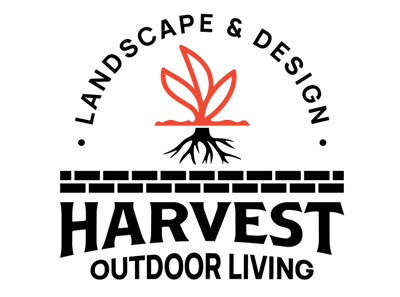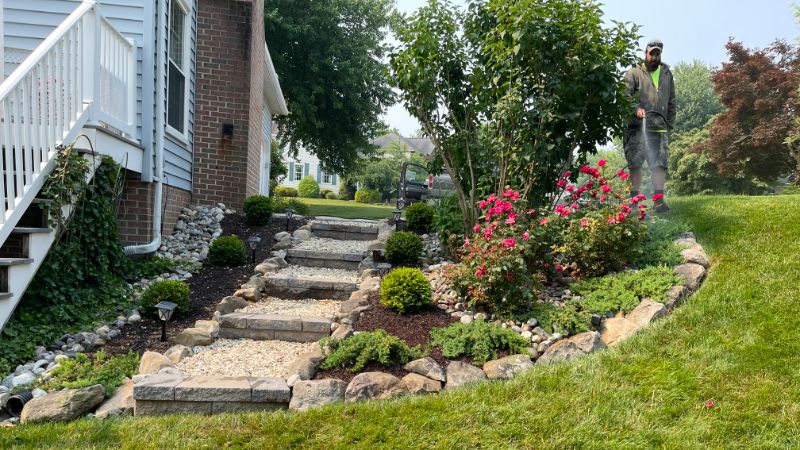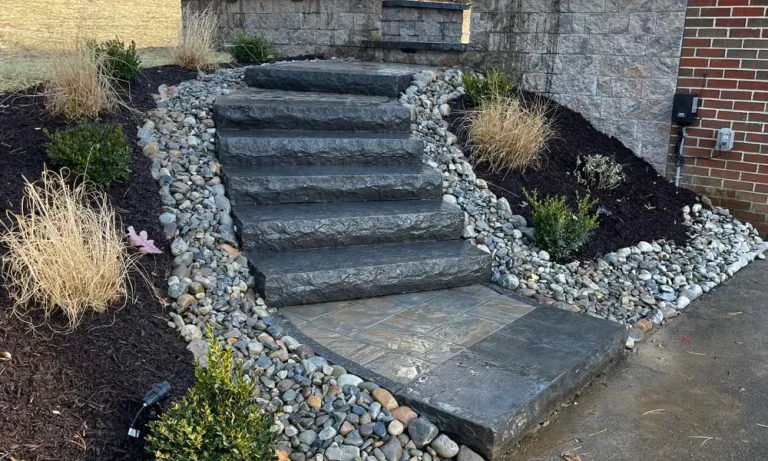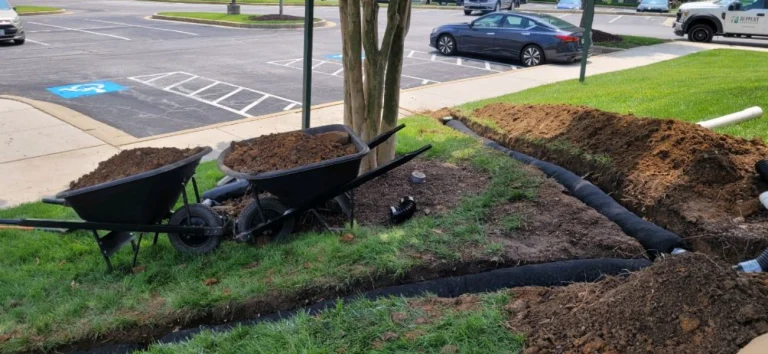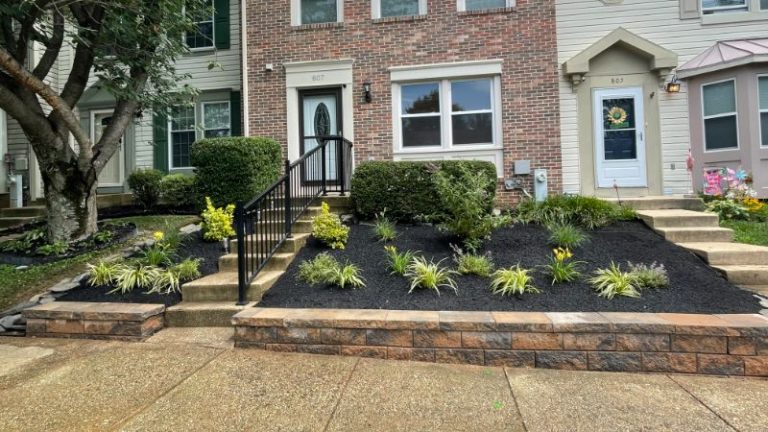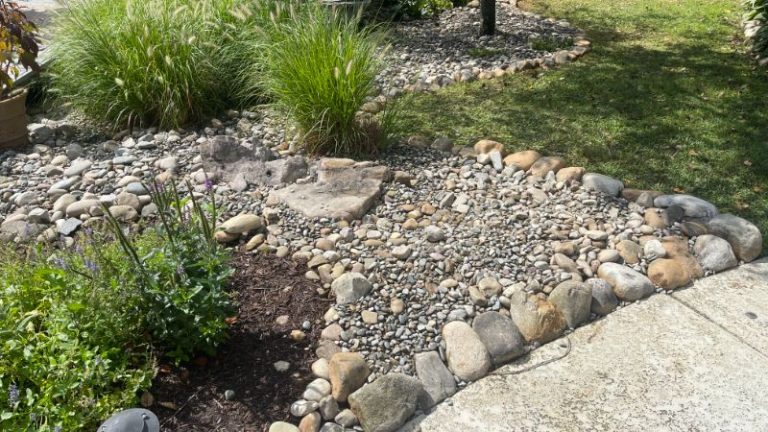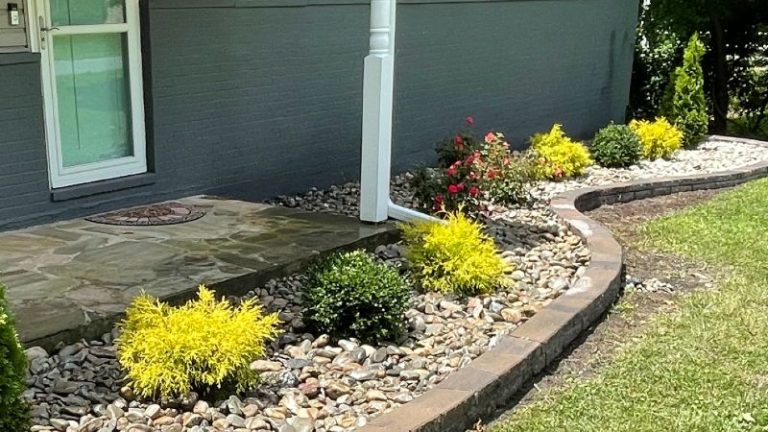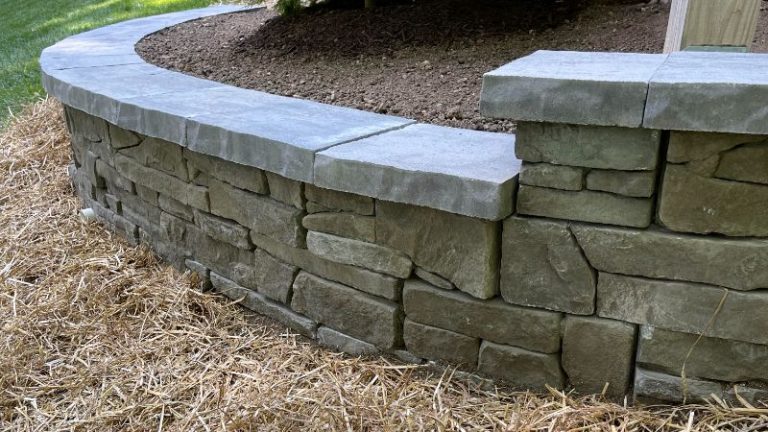Ideas for a Sloped Yard
If you live in a hilly town, sloped neighborhood, or rolling countryside, you know how intimidating it can feel when you are trying to landscape. Sloped yards can be difficult to walk on, awkward to work from, and challenging to maintain. They have an increased risk of soil erosion and sliding if handled poorly, which can be detrimental to both your landscape and your home.
However, hillside properties can lend themselves to some pretty incredible landscape designs so don’t be discouraged. From cut-in terraces to waterfalls, here are some of our top ideas for landscaping a sloped yard.
Build a Retaining Wall
You can turn your sloping yard into a flatter, more functional area by removing a portion of the slope and building a retaining wall to hold back the soil. The amount of effort, time, and money to execute a landscaped retaining wall depends largely on the size of the slope. The more soil needing to be retained the more complicated, and costly, the wall. This is one project you want to get right — repairing a failing wall can be expensive and painful. An experienced contractor can grade the newly levelled area property and build a retaining wall strong enough to support the surrounding earth.
A retaining wall creates a great spot for a dedicated planting area behind. The “hillside flower bed” can run the entire expanse of the wall, sporadically dot smaller sections all along, or be comprised of evenly spaced pots sitting atop landscape rocks. Depending on the material of the wall, the garden can even pop out from nooks and crannies on the wall’s surface.
Form Tiers
Not all sloped yards can manage a neat and tidy retaining wall. A strong slope in your yard can be problematic and could require one very tall retaining wall or, more likely, several tiers to help manage erosion and make the space functional. A tiered yard can combine a stunning multi-layered landscape design with a perfectly flat and practical grassy area. Use anything from traditional stone pavers to cost-efficient railroad ties to dramatically unique metal forms.
Build a Deck
Level the space by building a deck over the downward slope. You may be able to work the slope as is, or you may have to excavate a portion in order to get a level deck. Either way, the end result is less expensive than digging out or building up the entire area in an effort to get something flat. If there’s enough angle on the slope, you can free up space underneath for storage, another seating area, or a play space for children.
If you have a really steep hill or don’t want to have a massive one-dimensional deck, you could add multiple layers to the deck to break things up. A multi-level deck that straddles planted areas, whether natural or curated, allows more visual contrast. Multi-level decks will give your yard even, flat spaces that can be designated zones or rooms making more of the slope usable. Multi-level decks make it easier to work with the yard you already have rather than excavating and restructuring, saving you time and money. Another plus is that you can break up the deck building and spread it out over a number of years, adding a tier at a time.
Add Plants
Roots will help to anchor loose soil, so turn your slope into a beautiful garden to build stability and produce a scenic view. There are many planting options to choose from, but you should focus first on what you need and second on the look you want to achieve. For steeper slopes, you’ll want plants that form a mat of roots, such as shrubs, prairie plants, ornamental grasses, and groundcover plants. The dense mats reduce erosion and help prevent weeds from popping up making it a relatively low maintenance garden, which can be really beneficial for difficult to access areas.
Group Boulders
Anchoring boulders into the slope will help to secure the soil. Use larger rocks and make sure the bottom third, at a minimum, is buried and firmly pack soil around the base of the rock to ensure it’s stable enough to support the soil. To achieve a natural look that is also strong enough to secure the slope, cluster the rocks together in staggered, random patterns and finish by planting flowers, shrubs, and bushes.
Plant Grass
While not the easiest solution, it is possible to grow grass on a slope. Sod is a smoother installation process than seed and has a higher success rate of establishing, but either can be done. You want to make sure that water runoff is diverted properly prior to installation to help prevent erosion and overwatering. If you decide that sod is the best choice, it should run the length of the slope rather than top to bottom. The seams should be staggered for added stability and turf staples will help encourage the pieces to stay in place.
If you want to attempt seeding a slope, then hydroseed is your best option since the seed mixture (seed, mulch, fertilizer, and a bonding agent) adheres better to the ground. Plus, the installation method uses a sprayer to ensure even distribution.
Remember though, the challenges of a grassy slope don’t stop with installation. Mowing and other maintenance, such as fertilization and watering, can be very difficult.
Step it up
Adding stairs to your sloped yard will make moving around easier, but will also provide structure, giving the eye direction throughout the garden. Whether a step or two or an intricate winding staircase, steps can transform a sloped yard from inaccessible to inviting.
If your yard is on the wider side with a more gradual slope, you could consider wide, meandering steps to fit its size and scale. A zigzag staircase would work particularly well in a yard with a steeper slope since they are easier to climb than one with an aggressive incline.
Figuring out where to place your stairs can feel overwhelming, so a good tip is to start at the base of your slope and work up. Climb different pathways to help you find the best route. Another expert tip for landscaping staircases is to look at all the material options until you find the one that fits your style. Many homeowners stick with landscaping wood or pavers, but some get really creative and make a statement with colorful tiles or moss-covered mounds.
Add Water
Slopes lend themselves perfectly to a water feature. Whether it’s a discrete babbling creek or the ultimate showstopping waterfall, you can add as much or as little drama as you’d like. Water features are excellent at controlling erosion, and can also help to manage moisture levels.
A great bit of advice for planning the type, direction, size, and placement of your water feature is to try to work with what you’ve got, rather than going against the nature. Pay attention to, or even take pictures of, what your slope looks like during heavy rainfall. You’ll have the perfect blueprint for your water feature. Modify the natural path of the water if it’s too straight or you want to split/spread a single course of water across more area — it can make it more dynamic and dramatic.
At Harvest Outdoor Living, we’ve got the expertise to make your sloped yard into something beautiful. For more information about our services, call us at (443) 766-4831.
